BRITISH COLUMBIA
Society

Society
Popular destinations CANADA
| Alberta | British columbia | Manitoba |
| New brunswick | Newfoundland and labrador | Northwest territories |
| Nova scotia | Nunavut | Ontario |
| Prince edward island | Quebec | Saskatchwan |
| Yukon |
Society
State Structure
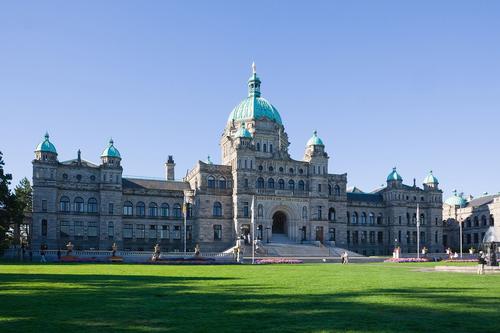 British Columbia Parliament Building in the capital VictoriaPhoto: Ikiwaner CC 3.0 Unported no changes made
British Columbia Parliament Building in the capital VictoriaPhoto: Ikiwaner CC 3.0 Unported no changes made
The Queen
Canada's ten provinces and three territories are part of a federation whose form of government is parliamentary democracy. Canada is an independent constitutional monarchy within the British Commonwealth and comprises a Crown, a Senate and a House of Representatives or House of Commons following the British (Westminster) model.
Canadian law recognizes the King or Queen, in this case Elizabeth II, as head of state. All federal laws are passed in the name of the King or Queen. Furthermore, it is mainly a ceremonial function.
The Governor General
The Governor General is the permanent representative of the King or Queen in Canada. The Governor-General is in principle appointed for a period of five years by the head of state on the advice of the Prime Minister of Canada.
One of the main duties of the Governor General is to ensure that Canada always has a Prime Minister. For example, if a party does not have a clear majority after elections or if the incumbent Governor General dies, the Governor General chooses a successor.
Furthermore, the Governor-General only acts on the advice of the Prime Minister and his cabinet. Other duties of the Governor-General are: convening parliament, opening and closing parliamentary sessions, reading the speech from the throne, giving royal approval to bills, signing state documents and dissolving parliament in new elections.
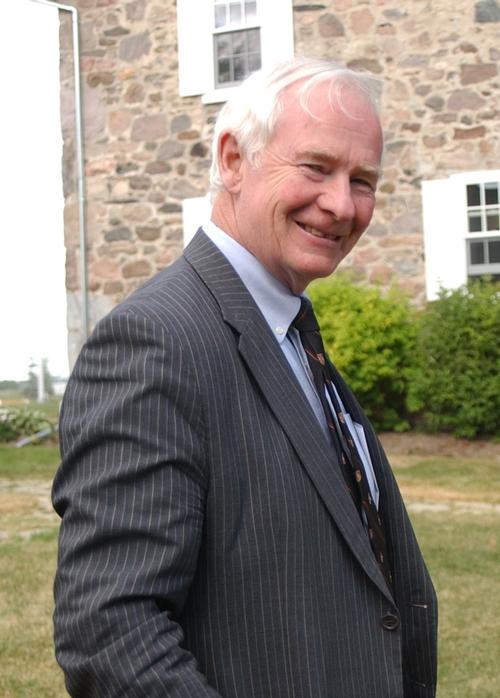 David Lloyd Johnston, 28th Governor General of CanadaPhoto: Valacosa CC 2.5 Generic no changes made
David Lloyd Johnston, 28th Governor General of CanadaPhoto: Valacosa CC 2.5 Generic no changes made
The Senate
The Senate studies, amends, and rejects or accepts bills passed in the House of Commons. The Senate can also introduce bills itself, but they must not cost public money or have to do with taxes, that is only the prerogative of the House of Representatives. No bill can become law without being reviewed by the Senate. Senators also study important social, legal and economic matters on committees. One of the Senate's other duties is to safeguard the interests of all Canadian regions, provinces, territories and minority groups.
The 105 seats of the Senate are distributed in such a way as to do justice to the size of the region. Senators are appointed by the Governor General on the intercession of the Prime Minister and may remain in the Senate until the age of 75.
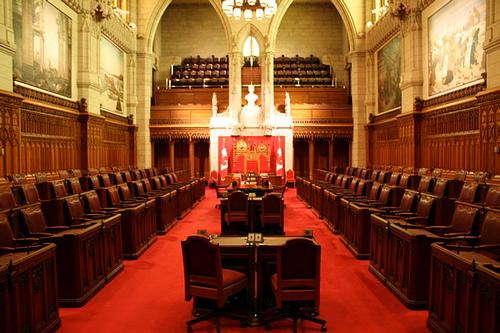 Canada Senate Meeting RoomPhoto: Makaristos in the public domain
Canada Senate Meeting RoomPhoto: Makaristos in the public domain
The House of Representatives
Most laws in Canada start as bills in the House of Commons, the House of Representatives or House of Commons, in the Netherlands the House of Representatives. Members of the House of Commons spend their time mainly debating and voting on bills. The House of Commons is also the place where members represent the views of their constituents, discuss national issues and monitor and hold the government to account.
To become a member of the House of Commons one must first participate in one of the 338 regional elections, 'constituencies' or 'ridings'. The candidate with the highest number of votes goes to the House of Commons, even if less than half of the votes are obtained.
The 338 seats in the House of Representatives, adjusted every ten years as necessary, are roughly distributed according to the number of people living in a province or territory. So the more residents, the more members in the House of Representatives. The condition is that each province or territory has at least as many seats in the House of Representatives as in the Senate. British Columbia currently has 42 representatives in the national House of Commons and 6 seats in the Senate.
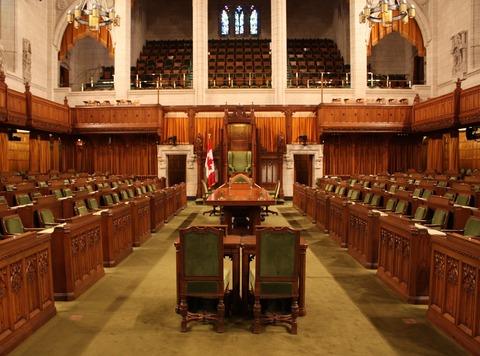 Meeting room 'House of Commons' CanadaPhoto: Makaristos in the public domain
Meeting room 'House of Commons' CanadaPhoto: Makaristos in the public domain
In 1982 a constitutional amendment was passed (Constitution Act 1982) which gave the Canadian Parliament the power to make changes to the Constitution itself without the prior consent of the British Parliament. Amendments to the Constitution require a decision from the federal parliament and seven provinces (together more than 50% of the population). Regional representation applies in the Senate and the 105 members are appointed by the Prime Minister, just like in Great Britain. The political weight of the Senate is quite small because the government decides on the candidacy of the Senate members. In addition, the Canadian cabinet is only answerable to the House of Commons, not to the Senate. The Senate is mainly concerned with amending bills.
The polity has a federal structure; each province, including British Columbia, has its own constitution, a Lieutenant Governor nominated by the Governor General who is nominated by the federal cabinet, and a unicameral Legislative Assembly.
The Lieutenant Governor of British Columbia represents the Queen in Canada at the provincial level and is the legal head of state of British Columbia, meaning he or she is the highest representative of the people and holds the highest position in provincial government.
The British Columbia Executive Council, also known as the Cabinet of British Columbia, consists of the Lieutenant Governor, the Prime Minister and his Cabinet Ministers, who are also members of Parliament and are elected by the Lieutenant Governor and the Prime Minister.
Since 2002, British Columbia has been the first Canadian province to hold parliamentary elections for the Legislative Assembly of British Columbia on a fixed day. These elections take place every four years on the second Tuesday in May. The next elections will be held on Tuesday 9 May 2017.
The number of parliamentary seats has increased over time from 25 before the first election in 1871 to the current 85 seats.
Canada is quite complicated legally. Statutes issued by the Federal Parliament are valid throughout the country; laws of the provincial legislature apply only in that province. Therefore, there are major differences in laws and regulations from province to province – insofar as they concern matters that fall within the competence of the province, of course. Criminal law is a federal matter and therefore the same throughout Canada.
Since joining the Confederation, British Columbia has had 34 prime ministers, fourteen of whom are non-party-aligned. Of the partisan prime ministers, three were Conservatives, eight were Liberals, four were from the British Columbia Social Credit Party (or Socreds), and five were New Democrats. The first prime minister was John Foster McCreight, who was sworn in in 1871.
Joseph Martin was Prime Minister for only 106 days, W.A.C. Bennett was the longest-serving prime minister to date at over twenty years and the only one to serve in four different cabinets. Kim Campbell of Port Alberni, though only five months in 1993, was Canada's first female Prime Minister and also the first British Columbia resident to ever hold the position. The current Prime Minister of British Columbia is Christy Clark, who was sworn in on March 14, 2011.
Administrative division
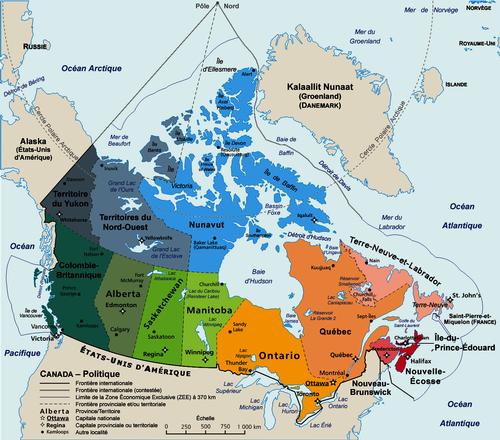 Canada Administrative DivisionPhoto: Public domain
Canada Administrative DivisionPhoto: Public domain
Since 1999, the federal state of Canada (established on July 1, 1867) has consisted of ten provinces and three 'territories'. Each province has a high degree of autonomy, which is reflected, among other things, in the power to regulate local government itself. Furthermore, it is largely self-sufficient in areas such as prison services, education, health care and taxation. The Crown is represented in each of the provinces by a Lieutenant Governor.
| Province | Capital | Surface | Inhabitants |
| Alberta | Edmonton | 948.000 km2 | 3.113.600 |
| British Columbia | Victoria | 661.200 km2 | 4.141.300 |
| Manitoba | Winnipeg | 650.000 km2 | 1.150.800 |
| New Brunswick | Fredericton | 73.500 km2 | 756.700 |
| Newfoundland & Labrador | St. John's | 406.000 km2 | 531.600 |
| Northwest Territories | Yellowknife | 3.300.000 km2 | 41.400 |
| Nova Scotia | Halifax | 55.000 km2 | 944.800 |
| Nunavut | Iqaluit | 1.900.000 km2 | 28.700 |
| Ontario | Toronto | 1.070.000 km2 | 12.068.300 |
| Prince Edward Island | Charlottetown | 5.657 km2 | 139.900 |
| Québec | Québec-City | 1.650.000 km2 | 7.455.200 |
| Saskatchewan | Regina | 651.900 km2 | 1.011.800 |
| Yukon Territory | Whitehorse | 536.000 km2 | 29.900 |
Sources
BBC - Country Profiles
British Columbia and the Rockies
Michelin Apa Publications
Canada
Cambium
Canada
Lonely Planet
CIA - World Factbook
Elmar Landeninformatie
Jepson, Tim / Vancouver en de Canadese Rockies
Wat & Hoe
Leigh Fleming, Janet / British Columbia : a walking guide
Cicerone
Ohlhoff, Kurt Jochen / Canada west & Alaska
ANWB
Phenix, Penny / Canada
Wat & Hoe
The rough guide to Canada
Rough Guides
Struijk, Aad / West-Canada
Elmar
Veldt, Marc / Canada
Gottmer/Becht
Ver Berkmoes, Ryan / British Columbia & the Yukon
Lonely Planet
Wagner, Heike / West-Canada : Alberta, British Columbia
Lannoo
Wikipedia
Last updated November 2025Copyright: Team The World of Info